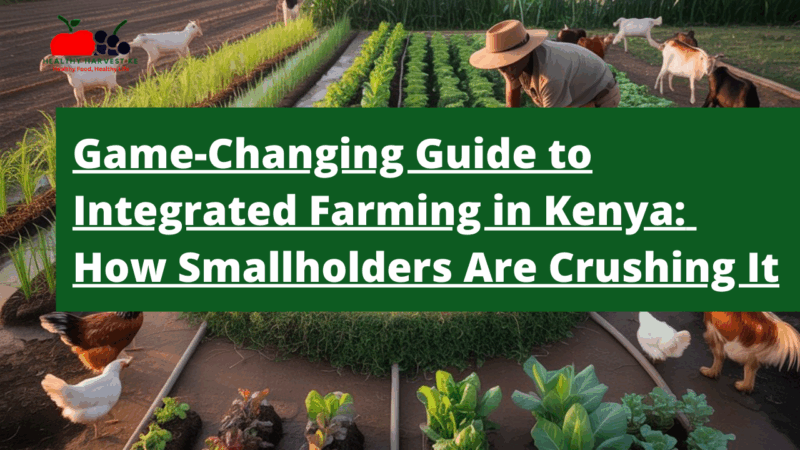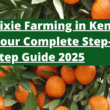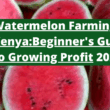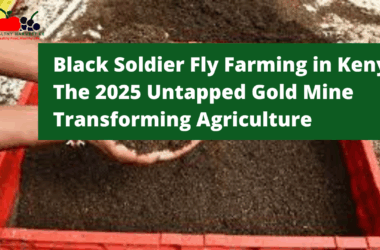What Makes Integrated Farming the Smart Play for Kenyan Smallholders
You’ve probably heard the buzz about integrated farming in Kenya, but what’s the real deal? Think of it as your farm’s perfect ecosystem – where nothing goes to waste and everything serves a purpose. Unlike conventional farming where you’re juggling separate operations, integrated farming connects all the dots.
In Kenya, this approach isn’t just trendy – it’s changing lives. Smallholders across counties like Siaya, Vihiga, Kitui, and Kakamega are seeing results that conventional farming just can’t match. When you combine crops with livestock, fish, and poultry in one smooth operation, you’re not just farming – you’re building a mini-empire where each piece supports the others.
The secret sauce? That “waste is only a misplaced resource” mindset. What your chickens don’t want becomes fish food. Fish pond water nourishes your crops. Crop residues feed your livestock. And around it goes, creating a closed loop that keeps money in your pocket while keeping resources on your farm.
The Evolution of Mixed Farming in Kenya
Integrated farming didn’t just appear overnight in Kenya. This approach gained serious traction in the mid-90s when farmers started looking for ways to meet both quality demands and environmental requirements without the strict constraints of organic farming.
What makes Kenya’s version unique is how it’s adapted to diverse local conditions. From the semi-arid stretches of Kitui to the more abundant rainfall areas of Kakamega, farmers have customized integrated systems to work with what they’ve got.
Studies across Kakamega, Nyeri, and Siaya counties show that most adopters go all-in with the comprehensive crop-fish-livestock integration model. Out of 166 farmers surveyed, 110 chose this complete approach rather than simpler two-component systems. That’s because the full integration maximizes those cross-component benefits that make this system so powerful.
Why Kenyan Smallholders Are Switching to Integrated Systems
Let’s cut to the chase – why should you care about integrated farming as a smallholder in Kenya? The benefits speak for themselves:
Year-Round Income Security
Unlike conventional farming where you’re at the mercy of seasonal harvests, integrated farming gives you multiple income streams that hit throughout the year. When your tomatoes aren’t ready, maybe your chickens are laying or your fish are market-size. This consistent cash flow is a game-changer for smallholders who need stability.
Slashing Input Costs
Why buy expensive fertilizers when your livestock produces premium organic manure? Why purchase commercial fish feed when your garden waste and chicken droppings can supplement it? Kenyan farmers who’ve embraced integration report significant drops in their input costs, sometimes by up to 60%.
Building Climate Resilience
With Kenya’s increasingly unpredictable weather patterns, putting all your eggs in one basket is risky business. Integrated farming spreads that risk across different enterprises. If drought hits your maize, maybe your drought-resistant fodder crops still feed your goats, keeping part of your farm productive even in tough conditions.
Boosting Soil Health Naturally
Conventional farming can strip your soil bare over time. But integrated approaches rebuild soil naturally through manure application, cover cropping, and crop rotation. Farmers in Siaya County have reported noticeable improvements in soil quality after just two seasons of integrated farming.
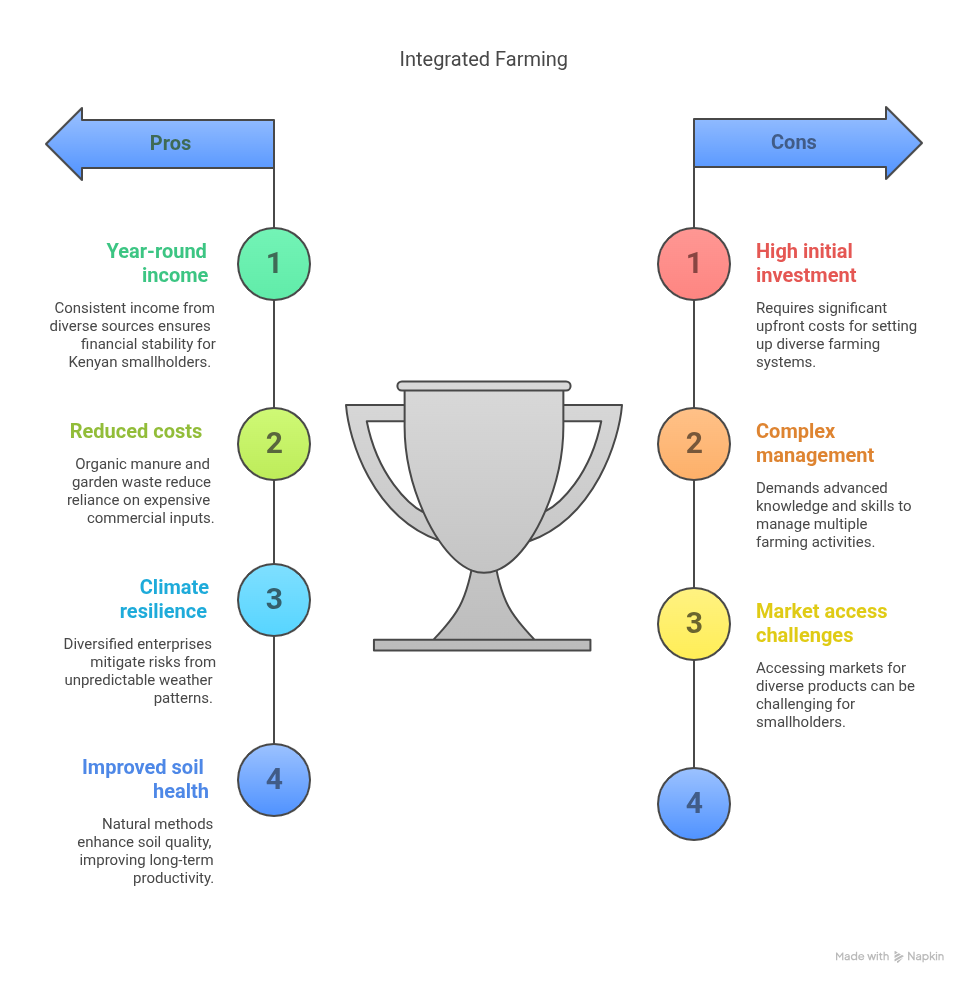
The Most Successful Integration Models in Kenya
Not all integrated farms look alike. Here’s what’s working best in different Kenyan regions:
The Fish-Crop Powerhouse
This popular model combines aquaculture with strategic crop production. The nutrient-rich water from fish ponds becomes liquid gold for irrigating crops, while crop residues can supplement fish feed. In Kakamega County, farmers practicing this model typically maintain 1-2 fish ponds (around 300m² total) alongside vegetable plots growing kale, spinach, and traditional vegetables.
The Livestock-Crop Combination
This classic approach integrates animals like dairy cows, goats, or chickens with complementary crops. The livestock provide manure while consuming crop residues and by-products. In Kitui County, combining drought-resistant fodder crops with small ruminants like goats has proven particularly effective in the semi-arid conditions. Elizabeth Kyalo’s system is a perfect example of how this works in challenging environments.
The Triple-Threat: Fish-Livestock-Crop Integration
The most comprehensive model incorporates all three components, creating multiple synergies. In Siaya County, Jane Aor’s impressive setup includes three fish ponds with 3,000 fish integrated with maize, poultry, bananas, vegetables, and hibiscus. This approach maximizes resource cycling and provides the most diverse income streams.
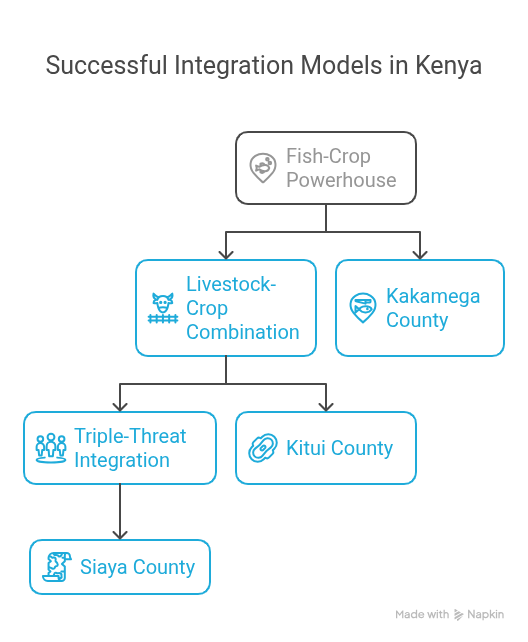
Real Success Stories from Kenyan Farms
Jane Aor: From Small Pond to Community Leader
Jane’s journey in Mbosie village, Siaya County, shows what’s possible with integrated farming. Starting in 2018 with minimal resources – just a small pond and a few fingerlings – she’s expanded to a comprehensive operation with three ponds holding 3,000 fish, alongside maize, poultry, bananas, vegetables, and hibiscus.
Her water management innovation stands out – digging a 5km trench from a distant spring to ensure consistent water supply for both her fish and crops. This kind of resourcefulness is what makes integrated farming work even with limited resources. Jane’s success has made her a role model for other aspiring farmers in the region.
Elizabeth Kyalo: Making it Work in Arid Kitui
Elizabeth faced the ultimate challenge – practicing integrated farming in Kitui County, one of Kenya’s arid regions where water scarcity threatens most agricultural efforts. Rather than giving up, she got creative.
After identifying water shortage as her main obstacle, Elizabeth learned to treat kitchen water with ash for reuse on her farm. This simple innovation allowed her to establish a thriving kitchen garden that provides both food for her household and extra income from sales to neighbors.
Elizabeth’s knowledge-sharing approach multiplied her impact. After training 25 community members in her techniques, they established their own kitchen gardens, creating a ripple effect of sustainable farming practices throughout her community.
Nyang’ori Boys’ High School: Growing the Next Generation of Farmers
Not all success stories come from individual farms. At Nyang’ori Boys’ High School in Vihiga County, students are learning integrated farming through the Norwegian Agency for Development Corporation’s Advancing Resilient Nutrition Sensitivity Aquaculture project.
The school’s circular system connects poultry, fish, and vegetables in a practical demonstration of integrated principles. Waste from poultry becomes fish inputs, which in turn benefits the vegetable component. Beyond producing diverse food for the school, this program is equipping young people with practical skills in sustainable agriculture – possibly Kenya’s most valuable crop.
Starting Your Own Integrated Farm: A Practical Guide
Ready to make the switch? Here’s how to begin your integrated farming journey:
Step 1: Assess Your Resources
Before diving in, take stock of what you’re working with:
- Land size and quality
- Water availability
- Existing infrastructure
- Labor capacity
- Initial investment capital
The beauty of integrated farming is that you can start small and scale up. Even a quarter-acre can support a basic integration of vegetables, a few chickens, and perhaps a small fish pond.
Step 2: Choose Your Components Wisely
Not every combination works in every location. Consider:
| Component | Good for | Challenges | Best paired with |
|---|---|---|---|
| Fish farming | Areas with reliable water | Requires technical knowledge | Vegetables, poultry |
| Dairy goats | Dry areas with browse | Need disease management | Fodder crops, vegetables |
| Poultry | Almost anywhere | Market fluctuations | Fish, vegetables |
| Vegetables | Areas with irrigation potential | Pest management | Fish, poultry, dairy |
Step 3: Design Your Integration Points
The magic happens in how your components connect. Plan these integration points carefully:
- How will manure be collected and applied?
- Where will water flow from one component to another?
- How will crop residues be processed for animal feed?
- What’s your rotation plan for crops?
Step 4: Start Small, Scale Smartly
Begin with just two well-managed components rather than trying to implement everything at once. Many successful Kenyan integrated farmers started with a simple crop-livestock integration before adding aquaculture or additional components.
For example, if you’re starting with goats and vegetables, focus on perfecting the manure-to-garden and fodder-to-goat connections before adding chickens or fish to the mix.
Overcoming the Top Challenges in Kenyan Integrated Farming
Even the best system has its hurdles. Here’s how successful Kenyan farmers are tackling the biggest challenges:
Water Scarcity Solutions
In areas like Kitui and Lari, water access makes or breaks integrated farms. Successful strategies include:
- Rainwater harvesting from roofs and runoff catchment
- Greywater recycling for garden irrigation (as Elizabeth Kyalo does)
- Drought-resistant crop selections
- Mulching to reduce evaporation
- Strategic water-efficient irrigation methods like drip systems
Knowledge and Training Gaps
Integrated farming requires more technical knowledge than conventional approaches. Successful farmers overcome this through:
- Joining farmer field schools and demonstration groups
- Seeking training from county agricultural extension officers
- Participating in farmer-to-farmer knowledge exchange
- Following established success models like those at Nyang’ori Boys’ High School
Initial Investment Hurdles
Starting an integrated farm can require more upfront investment than traditional farming. Smart approaches include:
- Phased implementation, starting with low-cost components
- Joining farmer savings and loan associations
- Exploring county government agricultural support programs
- Leveraging NGO partnerships that support sustainable agriculture
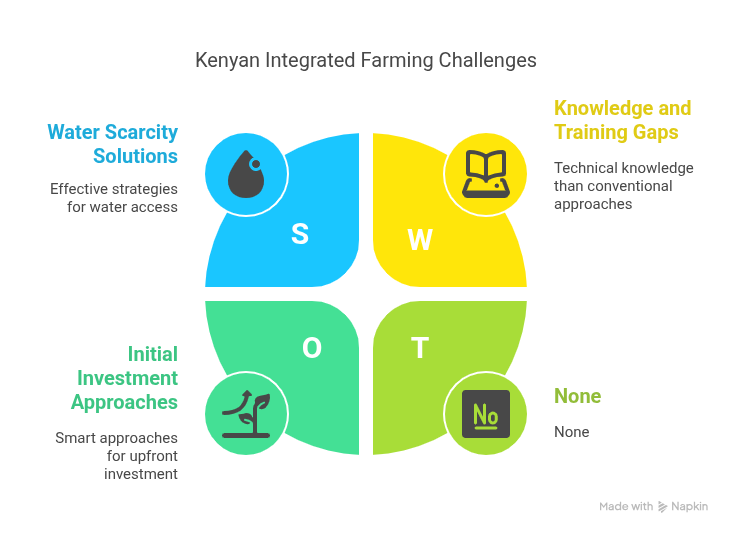
The Economic Case: Do the Numbers Add Up?
Let’s talk money – because that’s what ultimately matters for your farm’s survival. Research on Kenyan integrated farming systems confirms what successful practitioners already know: profit drives adoption.
Studies show that the mean profit has a highly significant positive effect on integrated agriculture adoption. In plain English: farmers who switch to integrated methods typically make more money than those sticking with conventional approaches.
Here’s a simplified comparison based on data from smallholder farms in Siaya County:
| Farming Approach | Average Net Income (KES/Year) | Initial Investment | Return Period |
|---|---|---|---|
| Conventional mono-cropping | 45,000 | Low | Seasonal |
| Basic crop-livestock | 72,000 | Medium | 3-6 months |
| Full integration (crop-livestock-fish) | 120,000+ | Higher | Multiple throughout year |
The higher returns from integrated systems provide the capital needed to invest in additional resources, technology, and training – creating a positive cycle of improvement and growth.
Future of Integrated Farming in Kenya: What’s Next?
The trajectory for integrated farming in Kenya looks promising as more success stories emerge and both government and development partners increase their support. Here’s what’s on the horizon:
Youth Engagement
The integration of farming systems into educational curricula, as seen at Nyang’ori Boys’ High School, represents a crucial development. These initiatives prepare students for potential careers in agriculture while promoting sustainable practices from an early age. As Principal Peter Lunani notes, students are genuinely passionate about this holistic approach to agriculture.
Scaling Successful Models
The individual success stories of farmers like Jane Aor and Elizabeth Kyalo provide models ready for wider adoption. Elizabeth’s training of 25 community members who subsequently established their own gardens shows how knowledge transfer can rapidly scale these approaches.
Institutional Support
Government agencies, county agricultural departments, development partners, and educational institutions are increasingly supporting integrated farming expansion. The collaboration between USAID Advancing Nutrition and the Kenyan government in supporting Elizabeth Kyalo’s venture exemplifies how partnerships can accelerate adoption of integrated farming approaches.
Conclusion: Why Integrated Farming is Kenya’s Future
Integrated farming isn’t just another agricultural trend – it’s a transformative approach that addresses multiple challenges facing Kenyan smallholders today. From resource efficiency and environmental conservation to food security and economic viability, these systems deliver results across the board.
The diverse success stories from different counties demonstrate how adaptable these approaches are to various agroecological zones and socioeconomic contexts. Whether you’re farming in arid Kitui or more fertile Siaya, there’s an integrated model that can work for your situation.
The challenges are real – water scarcity, knowledge gaps, and initial investment needs can seem daunting. But as Jane Aor, Elizabeth Kyalo, and many others have shown, innovative solutions emerge when farmers embrace the integrated mindset.
As you consider your own farming future, remember that the most successful integrated farmers start small, focus on connections between components, and continuously adapt their systems based on results. Your farm has unique potential – and integrated approaches might just be the key to unlocking it.
Ready to make the switch? The resources are out there, successful models exist, and the benefits are waiting. Kenya’s agricultural transformation is happening farm by farm – and yours could be next.
Have you implemented any integrated farming techniques on your land? Share your experience in the comments below, or ask questions about getting started with integrated farming in Kenya!




